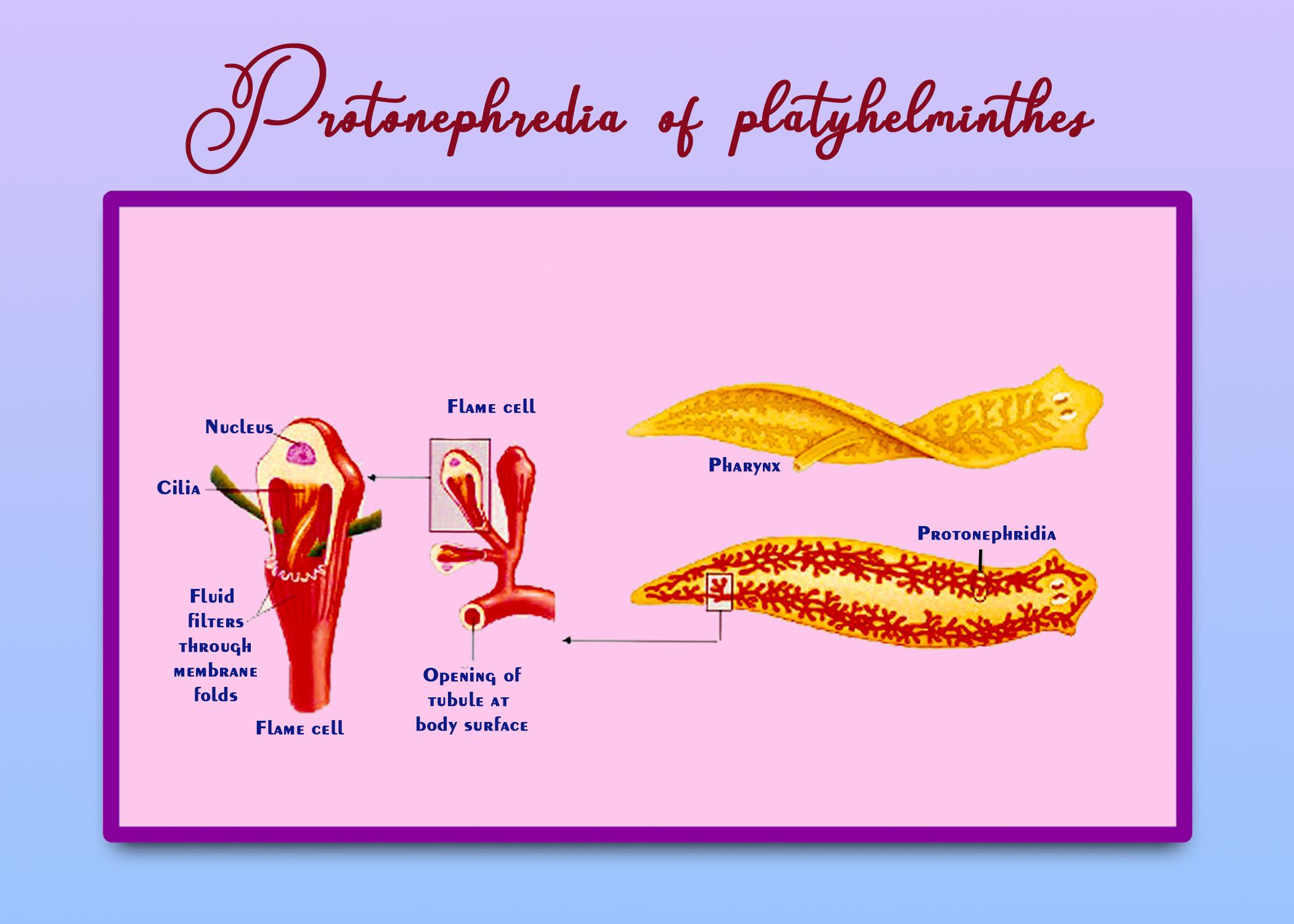
Protonephridia of fresh-water Platyhelminthes help in
(a) Excretion and Osmoregulation
(b)Nutrition and excretion
(c) Reproduction and Respiration
(d)secretion and Nutrition
Answer
459k+ views
Hint: A flame cell is a specialized excretory cell found in the simplest freshwater invertebrates, including flatworms, rotifers, and nemerteans. Bundles of flame cells are called Protonephridia.
Complete answer:
Protonephridia helps in osmoregulation or ion-regulation. They are also helpful in excretion. Flame cells function like a kidney, removing waste materials. Bundles of flame cells are called protonephridia. Protonephridium is a network of dead-end tubules lacking internal openings. These structures are common among the smallest invertebrates like flatworms, rotifers, and nemerteans. These are the simplest animals to have a dedicated excretory system. The flame cell has a nucleated cell body, with a cup-shaped projection. A number of flagella cover the inner surface of the cup. The beating of these flagella resembles a flame, giving the cell its name. The cup is attached to a tube cell. The inner surface of these tube cells is also coated with cilia, which help to move liquid through the tube cell. The tube opens externally through a nephropore, into an excretory bladder. The function of these cells is to regulate the osmotic pressure of the worm and maintain its ionic balance. Microvilli in the tube cell may be used to reabsorb some ions. Molecules enter the tubule in tube cells through the gap between the flame cell and tube cell for excretion.
Additional Information:
-Flatworms are a phylum of relatively simple bilaterian, unsegmented, soft-bodied invertebrates.
-They are acoelomates having no body cavity and have no specialized circulatory and respiratory organs.
-The digestive cavity has only one opening for both intakes of nutrients and removal of undigested wastes.
So, the correct answer is 'For excretion and Osmoregulation'.
Note:
-There are three main types of flatworms: flukes, planarians, and tapeworms.
-Some flatworms are free-living organisms, but most are parasitic. Most flatworms fall into the category of flukes or tapeworms, which are harmful parasites.
-Most flatworms are hermaphroditic and possess reproductive organs of both sexes. Hence, they have the ability to self-reproduce or reproduce sexually.

Complete answer:
Protonephridia helps in osmoregulation or ion-regulation. They are also helpful in excretion. Flame cells function like a kidney, removing waste materials. Bundles of flame cells are called protonephridia. Protonephridium is a network of dead-end tubules lacking internal openings. These structures are common among the smallest invertebrates like flatworms, rotifers, and nemerteans. These are the simplest animals to have a dedicated excretory system. The flame cell has a nucleated cell body, with a cup-shaped projection. A number of flagella cover the inner surface of the cup. The beating of these flagella resembles a flame, giving the cell its name. The cup is attached to a tube cell. The inner surface of these tube cells is also coated with cilia, which help to move liquid through the tube cell. The tube opens externally through a nephropore, into an excretory bladder. The function of these cells is to regulate the osmotic pressure of the worm and maintain its ionic balance. Microvilli in the tube cell may be used to reabsorb some ions. Molecules enter the tubule in tube cells through the gap between the flame cell and tube cell for excretion.
Additional Information:
-Flatworms are a phylum of relatively simple bilaterian, unsegmented, soft-bodied invertebrates.
-They are acoelomates having no body cavity and have no specialized circulatory and respiratory organs.
-The digestive cavity has only one opening for both intakes of nutrients and removal of undigested wastes.
So, the correct answer is 'For excretion and Osmoregulation'.
Note:
-There are three main types of flatworms: flukes, planarians, and tapeworms.
-Some flatworms are free-living organisms, but most are parasitic. Most flatworms fall into the category of flukes or tapeworms, which are harmful parasites.
-Most flatworms are hermaphroditic and possess reproductive organs of both sexes. Hence, they have the ability to self-reproduce or reproduce sexually.

Recently Updated Pages
Glucose when reduced with HI and red Phosphorus gives class 11 chemistry CBSE

The highest possible oxidation states of Uranium and class 11 chemistry CBSE

Find the value of x if the mode of the following data class 11 maths CBSE

Which of the following can be used in the Friedel Crafts class 11 chemistry CBSE

A sphere of mass 40 kg is attracted by a second sphere class 11 physics CBSE

Statement I Reactivity of aluminium decreases when class 11 chemistry CBSE

Trending doubts
10 examples of friction in our daily life

Difference Between Prokaryotic Cells and Eukaryotic Cells

One Metric ton is equal to kg A 10000 B 1000 C 100 class 11 physics CBSE

State and prove Bernoullis theorem class 11 physics CBSE

What organs are located on the left side of your body class 11 biology CBSE

Define least count of vernier callipers How do you class 11 physics CBSE




